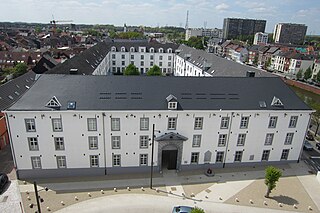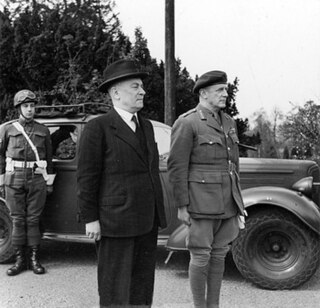
Léon Joseph Marie Ignace Degrelle was a Belgian Walloon politician and Nazi collaborator. He rose to prominence in Belgium in the 1930s as the leader of the Rexist Party (Rex). During the German occupation of Belgium during World War II, he enlisted in the German army and fought in the Walloon Legion on the Eastern Front. After the collapse of the Nazi regime, Degrelle escaped and went into exile in Francoist Spain, where he remained a prominent figure in neo-Nazi politics.

Fort Breendonk is a former military installation at Breendonk, near Mechelen, Belgium, which served as a Nazi prison camp (Auffanglager) during the German occupation of Belgium during World War II.

The Walloon Legion was a unit of the German Army (Wehrmacht) and later of the Waffen-SS recruited among French-speaking collaborationists in German-occupied Belgium during World War II. It was formed in the aftermath of the German invasion of the Soviet Union and fought on the Eastern Front alongside similar formations from other parts of German-occupied Western Europe.

The Belgian Resistance collectively refers to the resistance movements opposed to the German occupation of Belgium during World War II. Within Belgium, resistance was fragmented between many separate organizations, divided by region and political stances. The resistance included both men and women from both Walloon and Flemish parts of the country. Aside from sabotage of military infrastructure in the country and assassinations of collaborators, these groups also published large numbers of underground newspapers, gathered intelligence and maintained various escape networks that helped Allied airmen trapped behind enemy lines escape from German-occupied Europe.

Liberté chérie was a Masonic Lodge founded in 1943 by Belgian Resistance fighters and other political prisoners at Esterwegen concentration camp. It was one of the few lodges of Freemasons founded within a Nazi concentration camp during the Second World War.

The Free Belgian forces were soldiers from Belgium and its colonies who fought as part of the Allied armies during World War II, after the official Belgian surrender to Nazi Germany. It is distinct from the Belgian Resistance which existed in German-occupied Belgium.

The Mechelen transit camp, officially SS-Sammellager Mecheln in German, also known as the Dossin barracks, was a detention and deportation camp established in a former army barracks at Mechelen in German-occupied Belgium. It served as a point to gather Belgian Jews and Romani ahead of their deportation to concentration and extermination camps in Eastern Europe during the Holocaust.

The Military Administration in Belgium and Northern France was an interim occupation authority established during the Second World War by Nazi Germany that included present-day Belgium and the French departments of Nord and Pas-de-Calais. The administration was also responsible for governing the zone interdite, a narrow strip of territory running along the French northern and eastern borders. It remained in existence until July 1944. Plans to transfer Belgium from the military administration to a civilian administration were promoted by the SS, and Hitler had been ready to do so until Autumn 1942, when he put off the plans for what was intended to be temporary but ended up being permanent until the end of German occupation. The SS had suggested either Josef Terboven or Ernst Kaltenbrunner as the Reich Commissioner of the civilian administration.

The situation of Prisoners of war in World War I in Germany is an aspect of the conflict little covered by historical research. However, the number of soldiers imprisoned reached a little over seven million for all the belligerents, of whom around 2,400,000 were held by Germany.

The Belgian Government in London, also known as the Pierlot IV Government, was the government in exile of Belgium between October 1940 and September 1944 during World War II. The government was tripartite, involving ministers from the Catholic, Liberal and Labour Parties. After the invasion of Belgium by Nazi Germany in May 1940, the Belgian government, under Prime Minister Hubert Pierlot, fled first to Bordeaux in France and then to London, where it established itself as the only legitimate representation of Belgium to the Allies.

The royal question was a major political crisis in Belgium that lasted from 1945 to 1951, coming to a head between March and August 1950. The question at stake surrounded whether King Leopold III could return to the country and resume his constitutional role amid allegations that his actions during World War II had been contrary to the provisions of the Belgian Constitution. The crisis brought Belgium to the brink of a civil war. It was eventually resolved by the abdication of Leopold in favour of his son King Baudouin in 1951.

Despite being neutral at the start of World War II, Belgium and its colonial possessions found themselves at war after the country was invaded by German forces on 10 May 1940. After 18 days of fighting in which Belgian forces were pushed back into a small pocket in the north-west of the country, the Belgian military surrendered to the Germans, beginning an occupation that would endure until 1944. The surrender of 28 May was ordered by King Leopold III without the consultation of his government and sparked a political crisis after the war. Despite the capitulation, many Belgians managed to escape to the United Kingdom where they formed a government and army-in-exile on the Allied side.

The Political Prisoner's Cross 1940–1945 was a Belgian war medal established by royal decree of the Regent on 13 November 1947 and awarded to Belgian citizens arrested and interned by the Germans as political prisoners during the Second World War. The award's statute included provisions for posthumous award should the intended recipient not survive detention, and the right of the widow, the mother or the father of the deceased to wear the cross.

Although no precise estimates exist, the number of French soldiers captured by Nazi Germany during the Battle of France between May and June 1940 is generally recognised around 1.8 million, equivalent to around 10 percent of the total adult male population of France at the time. After a brief period of captivity in France, most of the prisoners were deported to Germany. In Germany, prisoners were incarcerated in Stalag or Oflag prison camps, according to rank, but the vast majority were soon transferred to work details (Kommandos) working in German agriculture or industry. Prisoners from the French colonial empire, however, remained in camps in France with poor living conditions as a result of Nazi racial ideologies.

The German occupation of Belgium during World War II began on 28 May 1940, when the Belgian army surrendered to German forces, and lasted until Belgium's liberation by the Western Allies between September 1944 and February 1945. It was the second time in less than thirty years that Germany had occupied Belgium.
Lieutenant-General Baron Albert Crahay was a Belgian soldier and historian. He is known particularly as the commander of the Belgian contingent in the Korean War and of the Belgian army of occupation in Germany.
Groupe Mémoire - Groep Herinnering (GM-GH) is a Belgian association set up in memory of the Belgian political prisoners of the Second World War.

During World War I Switzerland accepted 68,000 British, French and German wounded prisoners of war (POW) for recovery in mountain resorts. To be transferred the wounded had to have a disability that would negate their further military service or interned over 18 months and deteriorating mental health. The wounded were transferred from prisoner of war camps unable to cope with the number of wounded and sat out the war in Switzerland. The transfer was agreed between the warring powers and organised by the Red Cross. In all, 219,000 prisoners were exchanged.
Dr. Bernard Wilkin is a Belgian historian specialising in the history of modern warfare. He works at the State Archives of Belgium and is a Fellow of the Royal Historical Society. Dr. Wilkin is the author of twelve books and articles. During his career, he has worked on the history of aerial propaganda during the First World War, French morale during the Phoney War and is a specialist of the Napoleonic wars. His research on the fate of the bodies of those killed during the battle of Waterloo was widely publicized around the world.

Andrée Grandjean was a Belgian lawyer and a member of the Belgian Resistance during the Second World War. She was a leader in the Front de l'indépendance, a co-organiser of the Faux Soir newspaper act of resistance and a communist activist.



















